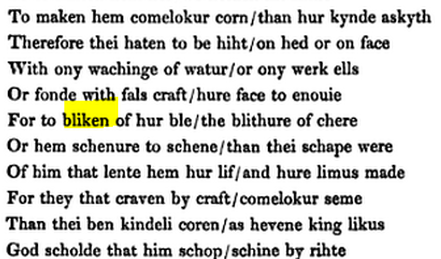|
CLICK HERE FOR KEY TO SOURCES
ETYMOLOGY From E-NED: here there appear to be two or more cognate forms: (1) Old English bliacucan to shine, gleam, a com. Teut. str. vb. = Old Saxon blîkan (MDu. blîken, Du. blijken to look, appear), OHG. (in comp.) -blîhhan (Middle High German blîchen, modern German -bleichen), Old Norse blîkja str. vb:—OTeut. *blîk-an ‘to shine, gleam,’ pointing to Aryan *bhlig-: cf. OSlav. bli-sk-atsupi to sparkle, Greek ϕλέγειν to burn, L.fulgēre to shine. (2) The cognate Old Norse blika (wk. v.) found beside the str. bliacukja to shine, glitter: cf. Sw. blicka, also MDu. and mod.G. blicken to glance, Dutch blikken to twinkle, turn pale. The early Middle English blikien points back to an OE. blician wk. vb., answering to Old Norse blika EXAMPLE From: The Alliterative Romance of Alexander From the Unique Manuscript in the Ashmolean Museum. Edited by the Reverend Joseph Stevenson, 1849 P. 211
0 Comments
Leave a Reply. |
Archives
September 2021
|

